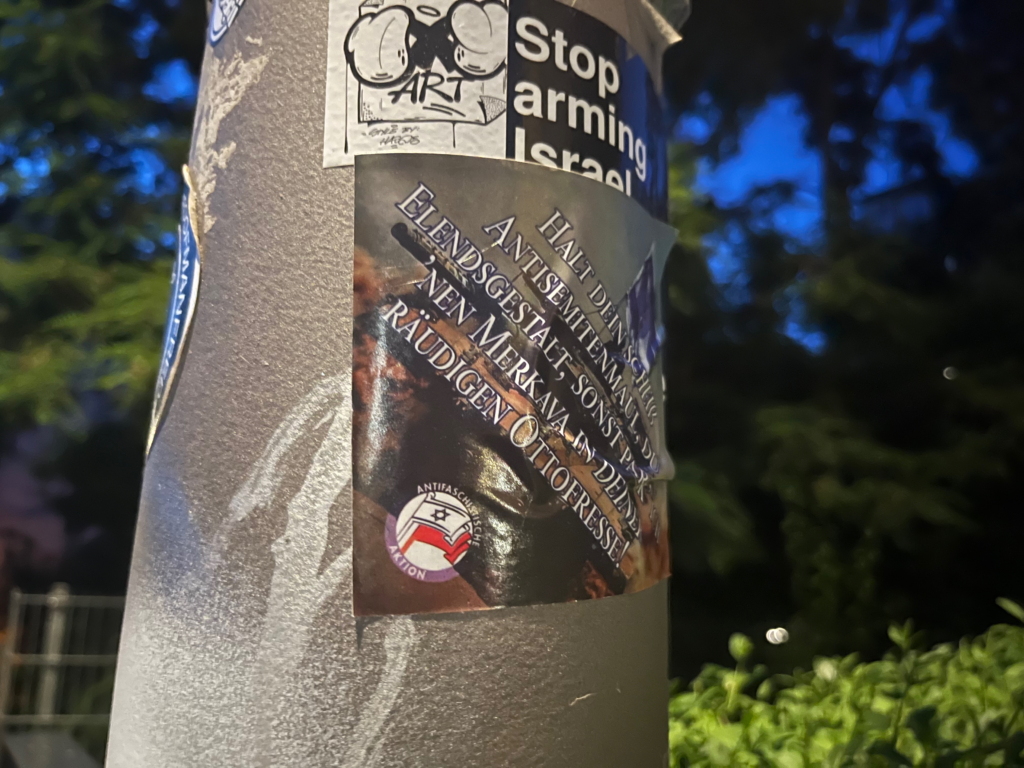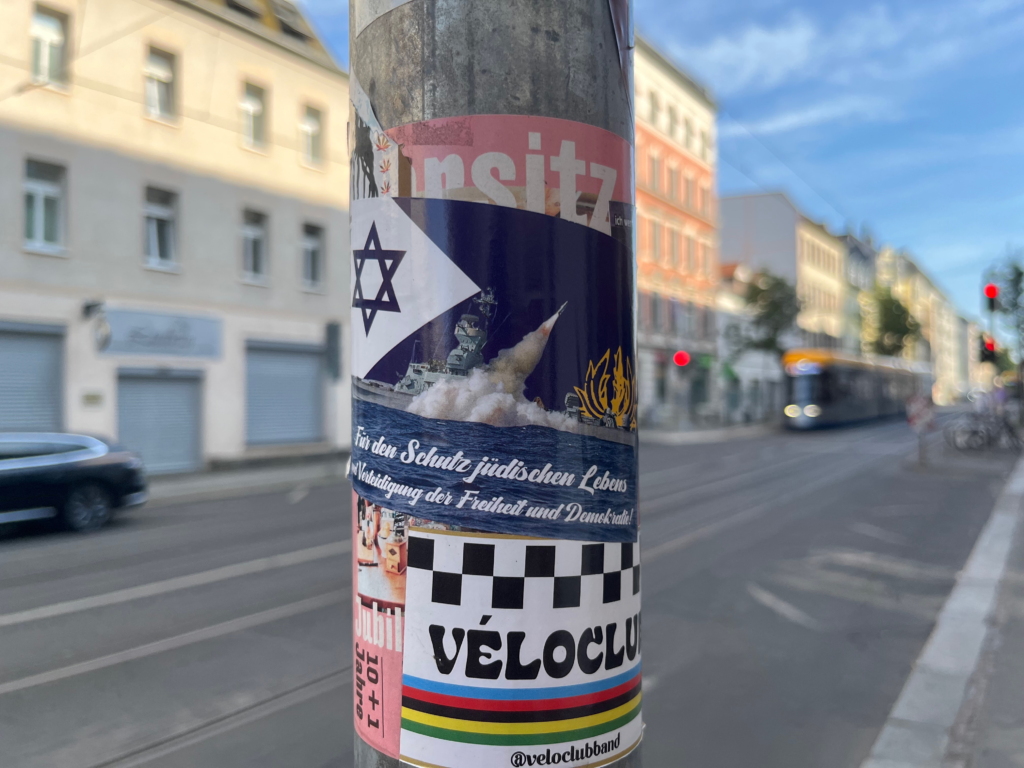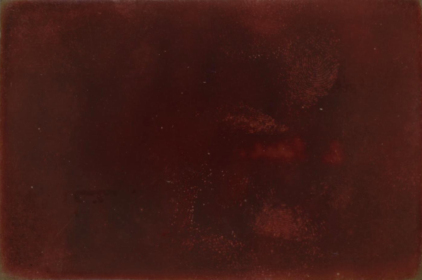Stickers Against Germany

IN LATE AUGUST, 2019, a blue municipal trash can in Leipzig stopped me in my tracks. Or rather, a sticker on a blue municipal trash can stopped me in my tracks. Looking over my shoulder, I took out my phone, snapped a photo, and peeled it off, only to throw it into the same trash can and walk away. The sticker, emblazoned with words as threatening as they were odd, was a stark reminder of the way people in my adopted home related to the country I grew up in: “The Mossad is going to get you,” it said in German, next to a logo of the Israeli intelligence agency. “Against any and every antisemitism,” it continued. “Am Yisrael Chai!” The last phrase, transliterated Hebrew for “the people of Israel live” — traditionally meaning something like “long live the Jewish people” — is something of a catchphrase for Israeli nationalists.

A few months prior, I had moved back to Germany after an intense six years in Tel Aviv, and on my return was added to a small Leipzig group chat of left-leaning Israelis. I sent the photo I had just taken and wrote something like, “folks around here are tripping hard.” My new friends were confused. Who is making threats in Germany in the name of Israeli intelligence? One friend wondered whether the sticker came from German Jews, drawing strength from the “Jewish state” in a hostile environment — or perhaps it came from neo-Nazis trying to scare Germans about scheming Jews.
While one can hardly know for sure with a sticker, it is safe to assume that the sticker’s origin was altogether different: It almost certainly came from young Germans with no Jewish background and was intended as a threat against Nazis, not propaganda for their cause. It has all the hallmarks of German left sectarian philosemitism — what is colloquially known as antideutsch.
Antideutsch — “anti-German” — is what a strain of the German radical left titled itself in the 1990s, morphing through the so-called Global War on Terror in the early 2000s into a political formation virtually unheard of outside Central Europe: anti-capitalist revolutionary leftists who champion the state of Israel and cheer on American interventions in the Middle East. In recent years, as fewer and fewer German leftists actively identify as antideutsch (bafflingly, they now prefer “ideologiekritisch” — “ideology-critical” — suggesting they are more inquisitive and less credulous of belief systems than others), opponents of this tendency continue using the term to refer to all those who seem to espouse leftist politics but vocally defend the state of Israel, or even to German supporters of Israel more broadly.
This is the movement from which the Mossad-inspired sticker I encountered in 2019 likely descends, deploying Israeli symbols not to meaningfully engage with Israel-Palestine but to carry out intra-German political struggles. The threatening, bombastic, yet somewhat whimsical style of the sticker exemplifies the strange aesthetic of the dwindling latter-day antideutsch youth scene, which has continued its rebellion long after Merkel declared Israeli power a foundational interest of the German state.
Indeed, despite any cognitive dissonance in the age of Staatsräson, this is a lasting feature of in the many stickers that I have encountered over the years, first in Leipzig and then Berlin (the former a traditional antideutsch stronghold). On many of these stickers, figures representing violence and power, real or imagined, often military and usually masculine, always derived from outside Germany (especially from Israel) are used to threaten antisemites (and “antisemites”) and to imagine forceful opposition to the German status quo and the afterlives of National Socialism:
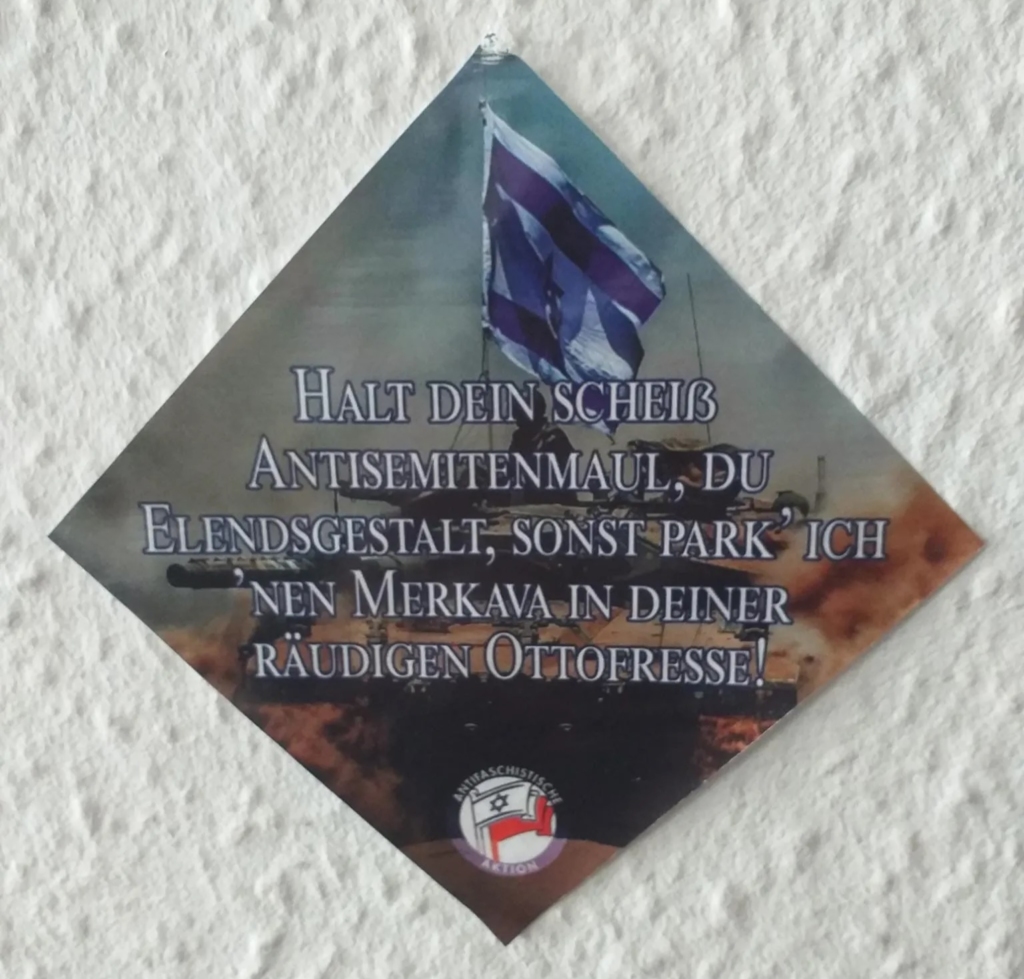

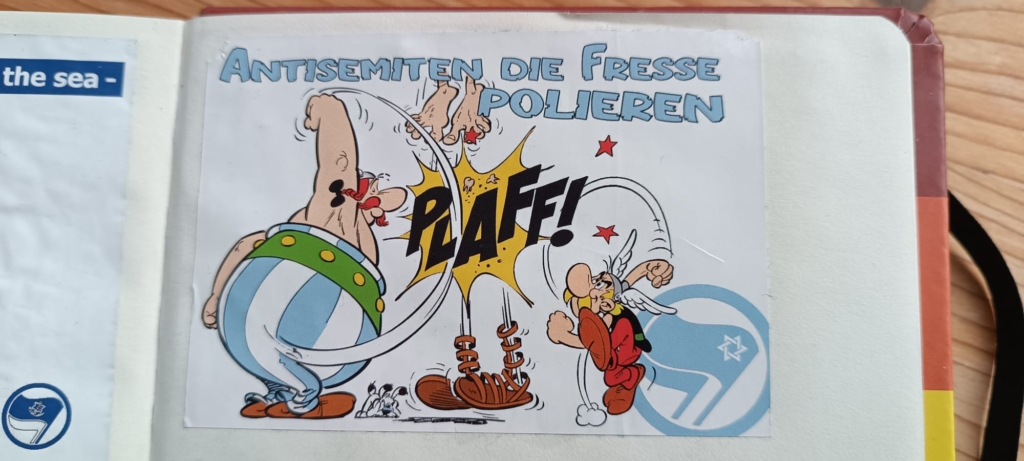
City Stickers
Mind you, antideutsch youth are far from the only ones spreading quirky and startling messages by means of stickers. German cities are practically plastered in them; lampposts, storefronts, and bathroom stalls are favorite targets, but no immovable surface in public space is immune. As a form of political praxis, stickering has a long history in Germany, with examples known to go back all the way to 1880. During the rise of Nazism in the 1920s and 1930s, both fascists and antifascists used this medium, applying stickers to places such as store fronts and postal envelopes.
Today, groups and organizations across the political spectrum produce and distribute stickers, but the most enthusiastic sticker warriors on city streets are certainly the youth of the radical left and extreme right. It is not so surprising that young people with marginalized political orientations are its most fervent practitioners: More-established communication channels are not open to them, and they lack more direct ways of realizing their political aspirations.
From that position, furtive stickering can feel empowering, a way to place your point of view where everyone can see it — all the more so when the stickers express brazen threats of violence, the likes of which one would never dare express in person.
Vulgar, Malignant, Dishonest
While stickers of all sorts revel in violent imagery, the place of the Israeli armed forces and Israeli state violence in antideutsch stickers is more specific: “Jewish power” stands in for direct antifascist action. While Germany has no shortage of neo-Nazis, outright violence against them is remarkably rare: the 2021 trial of Lina E. from Leipzig, who allegedly led a group in attacks on the far-right scene in Eisenach, was a national sensation, emphasizing how unusual such cases are — unlike the constant stream of far-right violence, mostly against migrantized people. But “anti-Germans” can compensate by outsourcing their power fantasy to a cartoon superhero like Asterix — or to a real foreign state and its military.
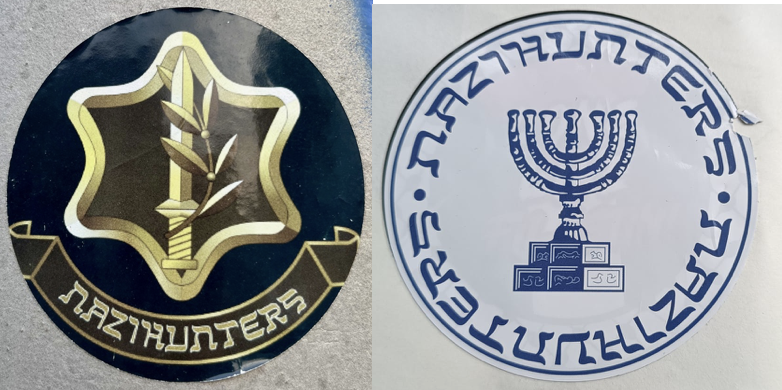
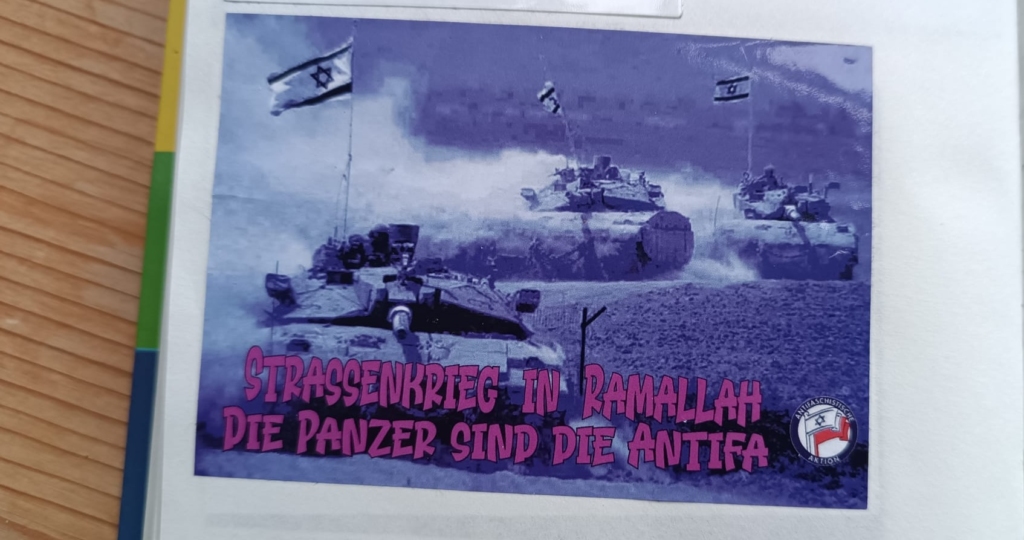
Of course, there are real, and famous precedents for Israeli armed forces hunting Nazis, as when they tracked down and brought Eichmann to trial in Jerusalem. But this is not what the Israeli military does, in Palestine least of all. No matter: Israeli militarism is a potent symbol for the anti-Germans because within their Manichean binary of German and Jew, the violence of the “Jewish state” serves as an imaginative riposte to German fascism, inverting the traditional antisemitic vision of the meek Jew as well as the German enthusiasm for military violence.
Crucially, this celebration of violence does not rely on empowering or arming any German — even the stickering “anti-Germans” themselves. Glorifying Israel externalizes and solves an internal problem for the would-be anti-Germans, a contradiction in the foundations of their thinking. They reject working-class militancy in Germany because they consider it inherently fascistic, not revolutionary — this was the essential starting point of the “anti-German critique.” So the antideutsch do not hope to spark a mass movement; it is such a movement they want to prevent. But true to their leftist prehistory, they also do not trust the German state.
The anti-Germans therefore require an external Hoffnungsträger (bearer of hope), even while the adulation of military power remains rooted firmly in the worst of German tradition.
In attaching their hopes to a foreign state, the antideutsch stand in a long and infamous tradition among radicals. Almost a century ago, George Orwell commented on such “transferred nationalism:” Among intellectuals, Orwell notes, it allows those who have stepped back from the nationalism of their own country to “wallow unrestrainedly in exactly those emotions from which he believes that he has emancipated himself. […] Transferred nationalism, like the use of scapegoats, is a way of attaining salvation without altering one’s conduct.” (Yossi Bartal brought these Orwell passages to bear on antideutsch ersatz nationalism in his brilliant short piece for The Left Berlin.)
The humor of anti-German stickers exemplifies the ability Orwell identified of the “transferred” nationalist “to be much more nationalistic — more vulgar, more silly, more malignant, more dishonest — than he could ever be on behalf of his native country, or any unit of which he had real knowledge.” Hence while actual Israeli propagandists may report supposed Hamas supporters to German police and my Israeli friends may fear that threatening Mossad persecution could foment actual antisemitism, the anti-German sticker kid promises to “park a Merkava tank” in supposed antisemites’ “dirty fool faces.”
Partying for the Cause
But alongside “malignant” and “dishonest” stickers that seem to imply Israeli armed forces ought to violently confront Nazis in Germany, sillier stickers draw on the somewhat less daring, but really-existing practice of “partying against fascism” — partying, that is, in cloistered, safe, antifa-themed nightclubs where one’s political opponents are unwelcome. (That will show them!)
I encountered a sticker riffing on this culture in Leipzig in 2022, while walking with my father, whose German skills did little to help him comprehend the menacing in-joke. What immediately catches one’s eye in the sticker is a long Israel flag in the upper part of the photo, seemingly held up by some figures standing behind the flag. In front of them, a crowd of figures in streetwear stand, their faces plastered over with identical images of a smiling man with bleached short hair. The sticker reads, “Antiimps wegscootern” or “Scooter away the anti-imperialists.”
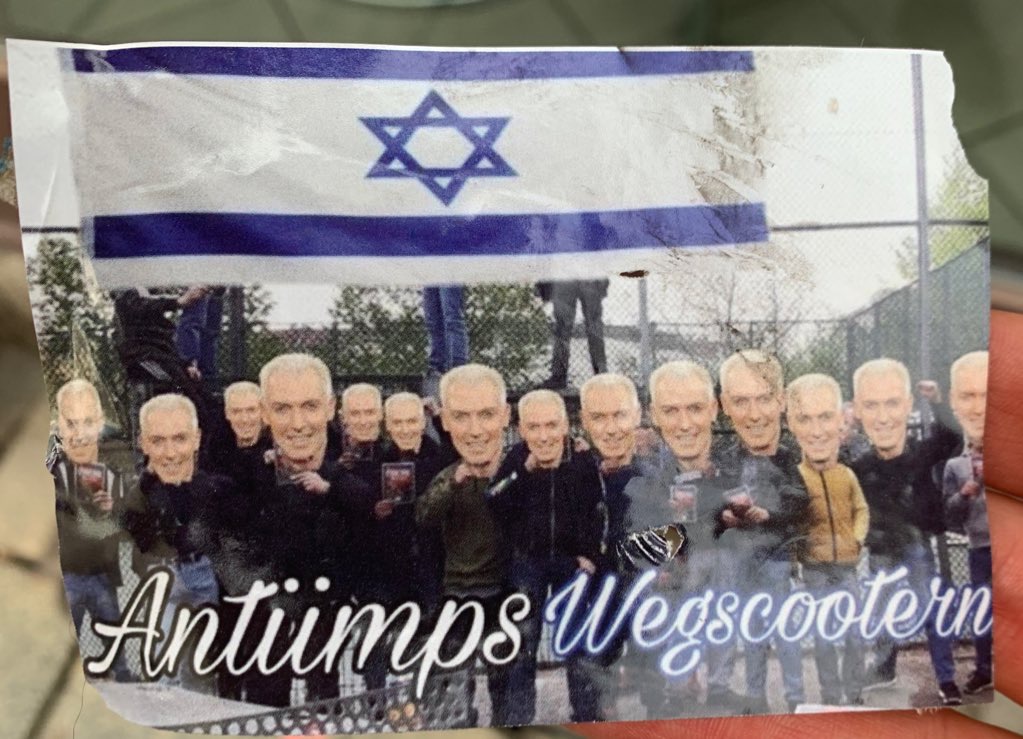
Some investigative research (read: posting the photo on Twitter) yielded an explanation: the original image showed a militant German far-left youth group holding up a Palestinian flag. The face copy-pasted over their heads is that of German techno musician H. P. Baxxter, of the band Scooter. Riffing on decades of party posters promising to “bass away the Nazis” (Nazis wegbassen), then, this sticker casts the pro-Palestinian militants as the reactionary threat, and a favorite musical act of the anti-German scene as a fun weapon against them.


The scene’s “antifascist night clubs” are an infamous front in Germany’s wars over political symbols, often played out through fashion. With explicit symbols of National Socialism banned in public, German fascists have had to resort to coded symbols, often as subtle as preferring certain clothing brands, such as Lonsdale or Elesse shirts (which can be worn such that only the “ns” or “ss” of the brands are visible). Keeping fascism at bay, then, has entailed identifying these symbols, stigmatizing them, and banning them where possible.
For the antideutsch, one lasting preoccupation has been the keffiyeh, a fashion accessory for German youth since the 1970s, known colloquially as “Palituch” or “Pali(stinian) scarf”, which became popular with neo-Nazis in the 1990s as an indirect sign of anti-Jewishness and anti-Americanism. Despite its broad importance in cultures across the Middle East, antideutsch stickers and right-wing commentators alike have reduced it to “a symbol of anti-Jewish hate” in connection with the Palestinian struggle.
By demeaning and rejecting cultural markers like the keffiyeh — while demanding adherence to a very specifically German world-view — cultural and political scenes enact a racializing and xenophobic code which demands that newcomers assimilate and discard their symbols and views. While antideutsch antifascists in places like Leipzig have fought generally for the rights of migrants, some individual migrants, especially Jews and people of color, have called them “ultra-German” racists and enforcers of their own unique brand of white supremacy.


Antifascist Nationalist
The insular, self-centered German nature of antideutsch thought puts it at odds with almost any other perspective — even those they putatively seek to protect. I would argue that one hallmark of antideutsch sticker designs is its awkward distance from any kind of Jewish or Israeli subjectivity. This distance is especially visible in the recurrent use of pseudo-Hebrew fonts, which are, ironically, damn hard to read if you are accustomed to reading actual Hebrew. While donning a Jewish costume, the message is very much about “The Jews”, not by, for or from Jews as independent subjects. And that is even before we address the content set in these philosemitic fonts.
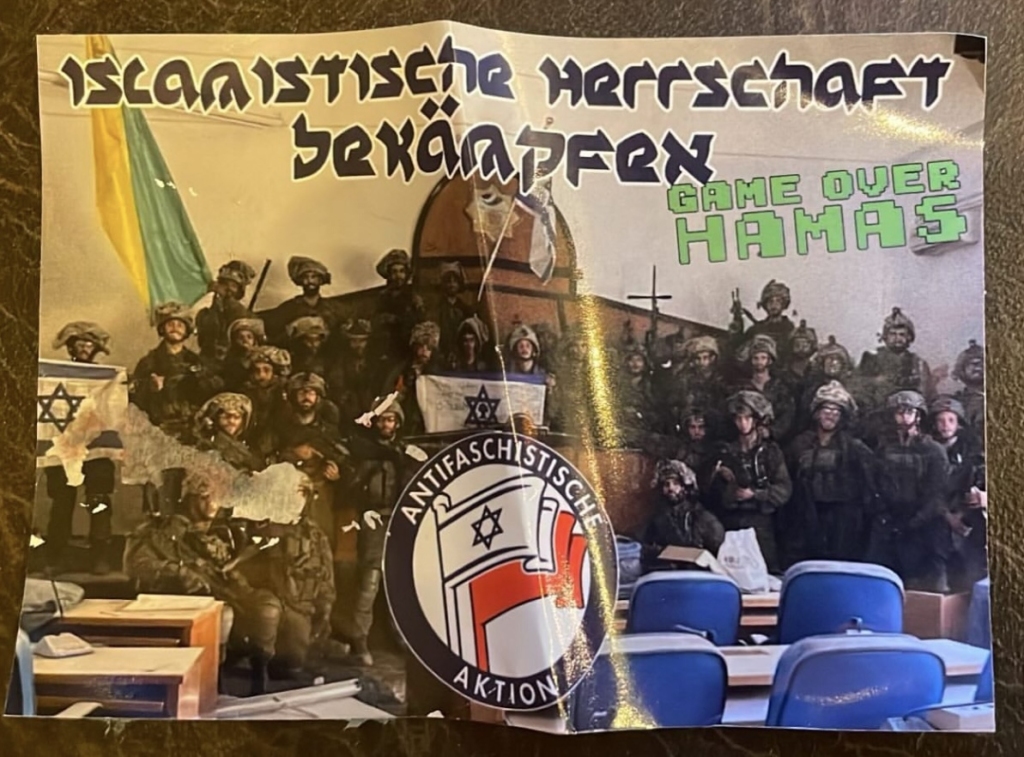

While certain German appropriations and reproductions of Zionism bear less of a direct connection with the antideutsch current specifically, the idiosyncratic combination of combative Zionist messaging with left symbols is the distinctive domain of that particular movement — distinct also from the long-marginal but venerable tradition of Zionist socialism. By far the most frequent of all left symbols in the antideutsch synthesis is the two-flagged Antifascist Action (Antifa) logo, which has seen countless adaptations, going back to the last-minute founding of Antifaschistische Aktion by the communist KPD in 1932. Its two flags are today most often red and black (communist and anarchist), but at times incorporate those of various liberation movements.
While nary a leftist would bat an eyelash at an Antifa logo featuring a Kurdish or pride flag, it is only in Germany that the Israeli flag is so frequently found in this symbol, in countless variations. The message is clear: The state of Israel is at the forefront of liberation, its endless war with the Palestinians and all peoples of the region a continuation of the left’s existential fight against fascism. In other words, bog-standard foreign-policy neoconservatism — but in Germany it can be coupled with progressive domestic policy and allowed to remain part of the left.

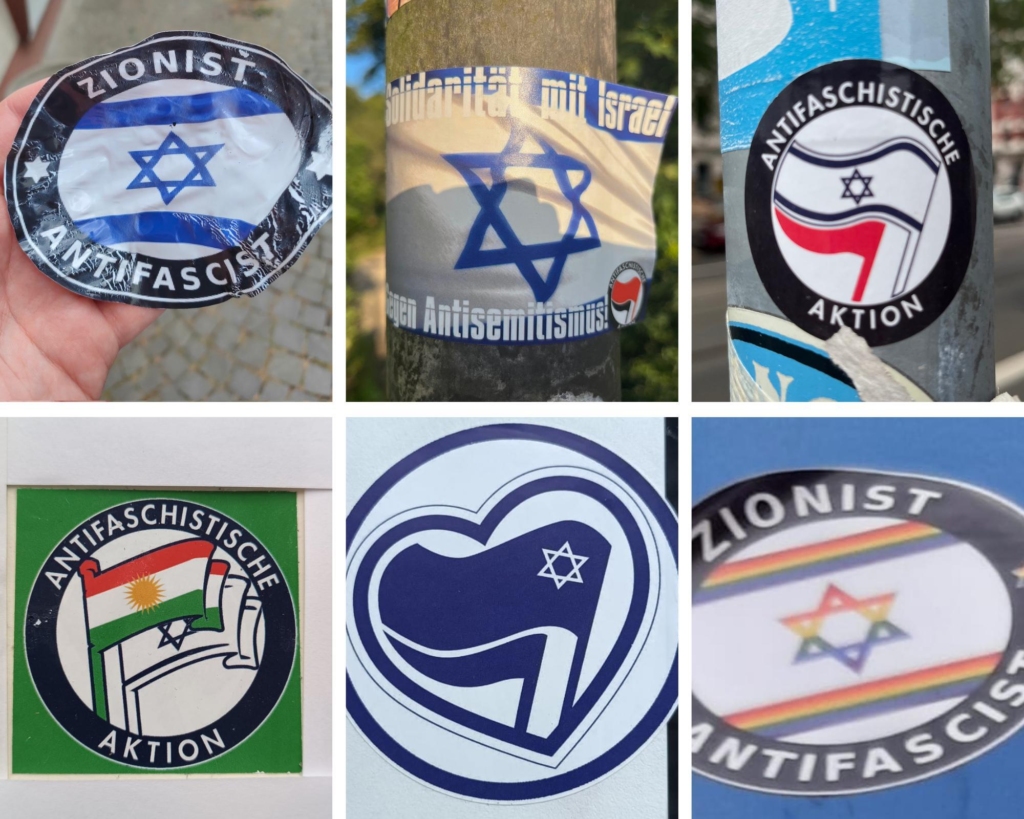
Old Victors and New Nazis
In line with this neoconservative turn, pro-Americanism is another peculiarity of antideutsch thought. Unlike in most countries where the left views the United States as a global oppressor, the German perspective is different, not least because of the American role in defeating Nazism and the U.S. military presence in Germany ever since. Those pining for those good old, bad old times have often articulated their patriotism as opposed to that presence — “Ami go home” — leading many on the left to push back and oppose anti-Americanism. This stance then dovetails naturally with the fetishization of Israel as stand-in for Europe’s murdered Jews; the Americans defeated Nazism and continue to defend its victims — they are “the real antifascists.”
But the extended “enemy-of-my-enemy” equivocation in this mythologized reimagining of antifascism leads to a startling, troubling conclusion: the people the United States and Israel now confront militarily in the Middle East are the “new Nazis.” Awkwardly, this places our erstwhile antifascists shoulder-to-shoulder with the German far-right they once sought to fight — together demonizing migrants for their supposed antisemitism and fascism.

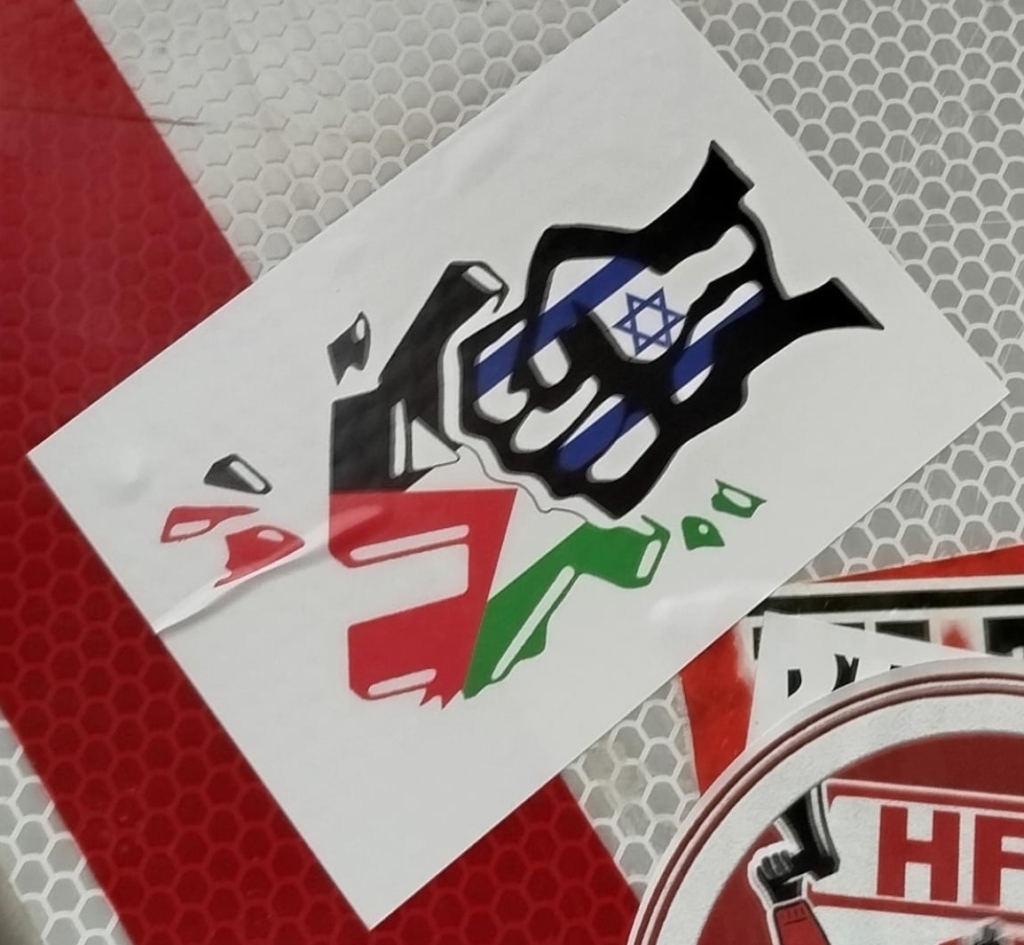
Never Mind the Nazis
In the early 2020s, the antideutsch had begun to markedly lose former prominence on the local left, even before the genocide in Gaza brought masses worldwide to the Palestinian cause. In Leipzig, where I lived until October 2023, organizers of Palestinian and other international backgrounds had managed to establish a lasting political presence, where once they were afraid to act in public. The local branch of Solid, the Left party’s youth wing, once proudly devoted to antideutsch indoctrination, had descended into splits and conflict and nearly ceased to exist.
Objective conditions had made the movement far less attractive. Outright fascists were gradually capturing state power in the supposed antifascist vanguards of America and Israel, while successive German governments affirmed the antideutsch’s main geopolitical position — absolute devotion to Israeli military security — as a supra-constitutional, foundational mission for Germany.
But the antideutsch project was never about geopolitics so much as Germans’ national sense of self and rejection of the collective Nazi past. But domestic political conditions were no help to their cause either: the German right and far right had learned to champion pro-Israelism and weaponize a xenophobic “fight against antisemitism” against its critics. To outside observers, the antideutsch seemed to be promoting the fascists’ agenda while proclaiming militant antifascism. Good luck recruiting young radicals for that!
Just months before October 7 and my concurrent move to Berlin, another Leipzig sticker encounter drove home how much the movement must be seen as a failure on its own terms. “It’s called NAZI,” the sticker reads, “not Israel-critic!” Gone is the mealy-mouthed “of course Israel can be criticized, but…” Now, not only is criticism of Israel Jew-hatred, but outright Nazism. What of the Nazis stricto sensu? Who cares, right? The real problem are those damned immigrants and their lefty friends.
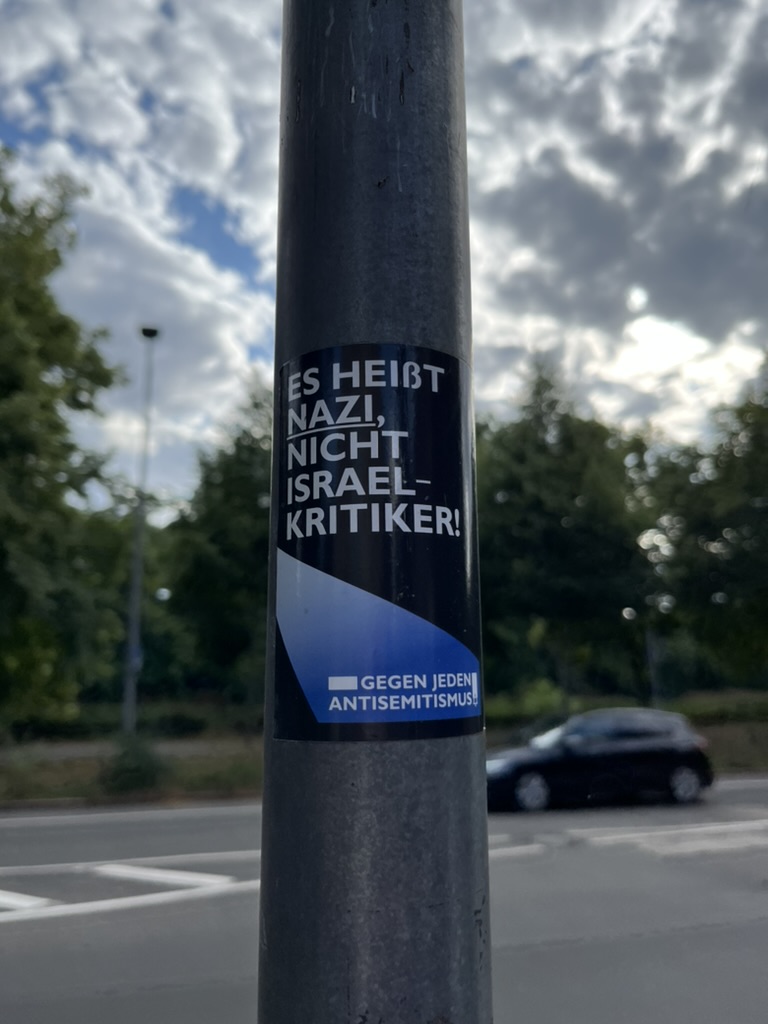
The displacement of Nazi guilt has taken many forms in the history of Germany coming-to-terms with its past, a form of denialism which the early antideutsch criticized. To this day, they wield the critique of displacement in some of their attacks on anti-Zionism: supposedly, decrying Israeli atrocities serves in the present only to set aside Germany’s atrocities of the past or to tar their victims. But it is the ultimate irony that from founding their political project in German guilt, the antideutsch have come to be part of the mainstream’s displacement, setting aside concern for homegrown Nazis in favor of fighting refugees, imagined as new Nazis. Oh, how the “ideology-critical” have fallen.
Epilogue: Keep Arming Israel
I moved to the United States from Germany last winter, putting a pause on my sticker documentation. I came to visit Germany this May, just as the federal government and media mainstream seemed to turn against Israel’s genocidal starvation of the devastated survivors remaining in Gaza. I visited Leipzig briefly during the days of the Israeli-American war on Iran in June, scouring familiar hotspots in the city’s west side for the latest in sticker warfare. My observations confirmed what local friends were telling me about the changing political scene: I saw more pro-Palestine stickers than pro-Israel ones, unthinkable for Leipzig as I had known it.
But the antideutsch have not gone away. While Israel’s unceasing lawless aggression and livestreamed genocide elicited ever-clearer rejection from activists and the broader public in Germany, and Germany’s right-wing Chancellor Friedrich Merz called Israel’s illegal attack on Iran “dirty work” that “Israel is doing for all of us,” Leipzig still had its neoconservative pseudo-left holdouts, cheering on the fascists in the name of antifascism, conducting their battles on lampposts and trashcans. Stop arming Israel? Shut your scheiß antisemite mouth!
